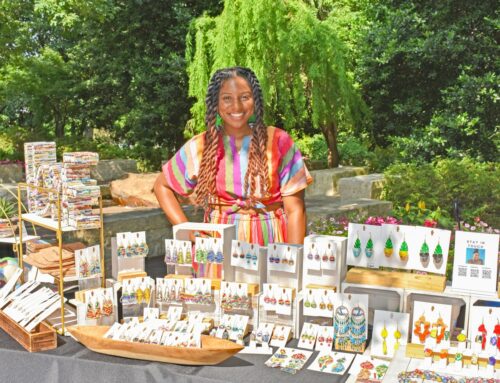These roller derby girls just want to have fun — pummeling each other
Being a Dallas roller derby girl is a bit of a dichotomy.
For starters, there’s the uniform — a helmet, mouth guard and kneepads ironically coupled with a mini skirt or hot pants and, in some cases, fishnets.
“People ask me, ‘What do you do? Girls in skirts on skates? What?’” says neighborhood resident Anne Daugherty, known in the Dallas derby world as June Carter Crash.
Then there’s the on-the-rink vs. off-the-rink mentality. The 110 women in the league practice together weekly and profess to be a sisterhood, or at least an anti-sorority. But when it comes time for a “bout,” or derby competition, anyone wearing a different uniform is fair game. And, yes, the fights are real.
“You get fired up out there,” says neighborhood resident Logan Briggs, a.k.a. Motor Lisa. “There are rowdy guys drinking beer, and this girl knocks you over and you fall, and you look stupid, and everybody goes ‘oooooh.’ You are going to get up and whoop her — you’re not thinking, ‘This is my buddy.’”
And, of course, there’s the dual personality aspect. These women are homemakers, students, artists, lawyers and business owners, but when they step into their skates, each sheds the role of nurturer or professional and takes on a tough chick alter-ego bolstered by a name like “Razen Cane” or “Ultra Violence.”
“None of these girls when you meet them come across that way, but get ’em on the rink, and it’s a different story,” Daugherty says. “Each girl has another persona that they can live out through their character.”
It’s an empowering schizophrenia, giving them the freedom to unleash pent up energy, creativity, even confidence, and it all converges on the rink, making the bouts an absolute blast to watch.
The Dallas Derby Devils formed in late 2004, inspired by an exhibition bout that came through town featuring the Texas Rollergirls from Austin. The brassier reincarnation of the ’70s roller derby craze appealed to a number of 20- and 30-something women, including some in our neighborhood.
“I wanted to learn how to do that — to look that good on skates,” says Mary Beach, a.k.a. Mary Massacre. “I wanted to be a part of it because I knew it was going to be something a lot bigger.”
Some recruits, such as Angela Brandes, who’s Jersey Runaway when on her wheels, grew up on the skating rink. That’s where she and her friends spent their weekends, celebrated birthday parties and formed their identities.
“The happiest times of my life are when I have roller skates on,” Brandes says.
For others, the attraction lay in the league’s opportunities for athleticism or creativity, or in the case of Briggs, both. In high school, she was a self-described “art jock” — the field hockey team captain, a crew team member and an advanced placement art student.
“It just sounded too perfect for me,” Briggs says of the Dallas Derby Devils. “I was severely lacking something in my life, something to be passionate about. I needed something to sink myself into, and it just happened.”
The women are quick to clarify that athletic experience and skating skills are not prerequisites to join. Beach, who attended the Dallas arts magnet school, is a testament to this.
“I never in my wildest dreams thought that I would become a jock spending a lot of time in front of the mirror and flexing muscles and becoming the nastiest meathead that I despise,” she laughs.
Size doesn’t matter either, they insist. Skinny girls usually have the advantage when it comes to lapping opponents and scoring points, but a little more meat certainly helps when you need to thrust a hip or shoulder to take someone down. Or when the refs penalize you for fighting, which requires you to pull on oversized boxing gloves and go after the girl who has it in for you — while still wearing skates. (Whoever’s left standing, wins.)
Needless to say, a little gumption doesn’t hurt either. It takes a certain penchant for partying (Lindsay Parker, a.k.a. Made’n Texas, was recruited while dancing on a bar), and the women readily admit they love the superstar aspect of fans chanting their names and asking for autographs.
But the derby requires more than a flair for the theatrical. It also takes serious commitment — three practices a week and at least two promotional events a month, plus the bouts and any other individual prep. The women who survive the grueling schedule suddenly find that their best friends are the people skating alongside them.
“My boyfriend is incredibly jealous of all the time and devotion I have toward derby,” Parker says. “That’s just a harsh reality.”
The camaraderie in the “sorority of the bruised girls,” as Brandes calls it, has helped some league members through hard times. Briggs was diagnosed with rheumatoid arthritis a few years ago, which forces her to sit out some practices and even bouts. But she’s her team’s captain, not to mention a tough cookie.
“If there are people there depending on me, it motivates me to get going,” she says. “My doctor doesn’t know I do it. I don’t want him to tell me I can’t do it. I tell him that I roller skate for exercise.”
Brandes depended on the distraction of roller derby as she struggled through a divorce. It’s a place where people often find the nourishment to blossom, she says.
“There’s this moment when you stop being afraid to get hit, and you stop being afraid to fall down, and in that moment you can’t believe the confidence that comes through for you,” Brandes says.
Her moment came when a 6-foot-tall “thick girl” checked her during a practice. She didn’t see her coming, and her petite 5-foot-1 frame went flying across the rink, landing on her hip.
As hard as they train — learning how to skate, how to maneuver, even how to properly fall — injuries are inevitable. Skid burns and rainbow-colored bruises are the most common battle scars, but there’s the occasional shoulder dislocation or torn knee ligament.
Roller derby is often compared to professional wrestling, a correlation the participants detest because it suggests the sport is a charade. It’s more like rugby, they argue, but with skates and without a ball. Sure, there are tawdry uniforms and garish make-up — “It’s 90 percent athleticism and 10 percent spectacle,” Briggs says — but that 10 percent is mainly a marketing mechanism.
“We know the crowd doesn’t come just to see girls skate — they come to see the fights. We work super hard to skate our hearts out, but that doesn’t sell tickets all the time,” Parker says.
Such fanfare draws a crowd that “is not your typical young rock-and-roll-type crew,” Mary says. The women’s parents attend, as do people who remember roller derby from the ’70s. Others come not to watch the spectacle but to create their own.
“We had one guy dressed up like a devil who walked around for a while, then out of nowhere came this Jesus, and he was chasing the devil around all night,” Mary says. “It’s not necessarily for the conservative crowd, but it’s entertaining nonetheless.”





